A Report on Health and Safety at Work: The Ladbroke Grove Rail Crash
VerifiedAdded on 2022/11/25
|11
|2641
|404
Report
AI Summary
This report examines the Ladbroke Grove Rail Crash, a significant incident caused by health and safety violations in the UK rail system. It details the crash's occurrence, which resulted in numerous fatalities and injuries. The report identifies key contributing factors, including driver training deficiencies, signal failures, and inadequate safety protocols by both the train operating companies and Railtrack. It highlights specific safety breaches, such as Thames Trains' failure to adhere to driver recruitment and training procedures, as well as Railtrack's inaction regarding known signal visibility issues and SPADs. The report then outlines the policy changes implemented following the public inquiry, including the formation of the Rail Safety and Standards Board (RSSB) and the Rail Accident Investigation Branch (RAIB), which aimed to improve safety standards and accident investigation processes. The report concludes by emphasizing the role of driver vigilance and the importance of robust safety systems in preventing future rail accidents.

Running head: HEALTH AND SAFETY AT WORK 1
Health and Safety 1 at Work
Name
Institutional Affiliation
Health and Safety 1 at Work
Name
Institutional Affiliation
Paraphrase This Document
Need a fresh take? Get an instant paraphrase of this document with our AI Paraphraser

HEALTH AND SAFETY AT WORK 2
HEALTH AND SAFETY AT WORK
Executive Summary
Australia has increasingly faced challenges with train crashes due to H&S violations.
This paper discusses the Ladbroke Grove Rail Crash, a train incident which took place due to
safety breaches to show how safety breaches led to this accident. Specifically, the discussion
focuses on the safety breaches that heavily contributed to this accident and examines the policy
changes that have been effected as a result of this crash and how the changes were
executed/implemented.
HEALTH AND SAFETY AT WORK
Executive Summary
Australia has increasingly faced challenges with train crashes due to H&S violations.
This paper discusses the Ladbroke Grove Rail Crash, a train incident which took place due to
safety breaches to show how safety breaches led to this accident. Specifically, the discussion
focuses on the safety breaches that heavily contributed to this accident and examines the policy
changes that have been effected as a result of this crash and how the changes were
executed/implemented.
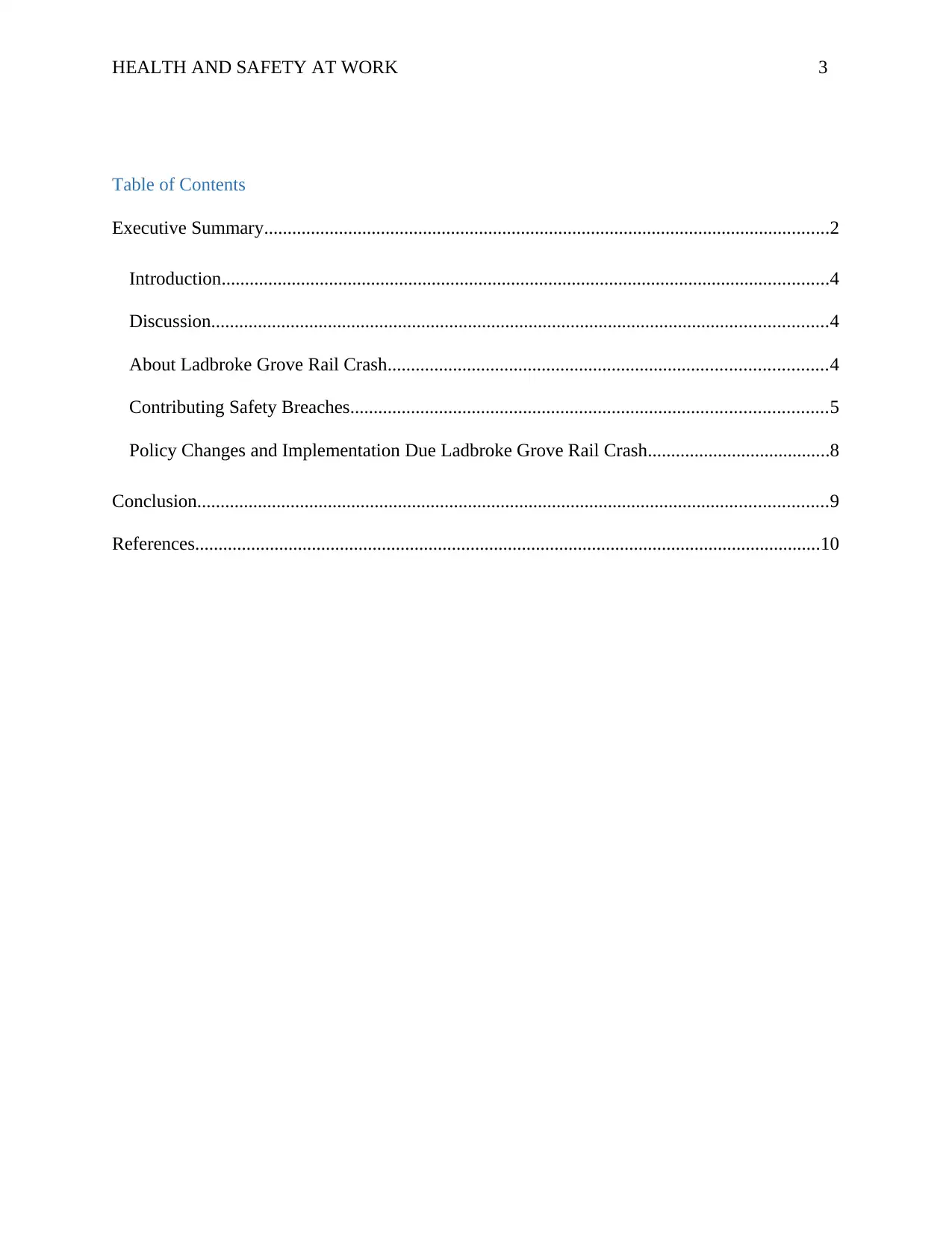
HEALTH AND SAFETY AT WORK 3
Table of Contents
Executive Summary.........................................................................................................................2
Introduction..................................................................................................................................4
Discussion....................................................................................................................................4
About Ladbroke Grove Rail Crash..............................................................................................4
Contributing Safety Breaches......................................................................................................5
Policy Changes and Implementation Due Ladbroke Grove Rail Crash.......................................8
Conclusion.......................................................................................................................................9
References......................................................................................................................................10
Table of Contents
Executive Summary.........................................................................................................................2
Introduction..................................................................................................................................4
Discussion....................................................................................................................................4
About Ladbroke Grove Rail Crash..............................................................................................4
Contributing Safety Breaches......................................................................................................5
Policy Changes and Implementation Due Ladbroke Grove Rail Crash.......................................8
Conclusion.......................................................................................................................................9
References......................................................................................................................................10
⊘ This is a preview!⊘
Do you want full access?
Subscribe today to unlock all pages.

Trusted by 1+ million students worldwide
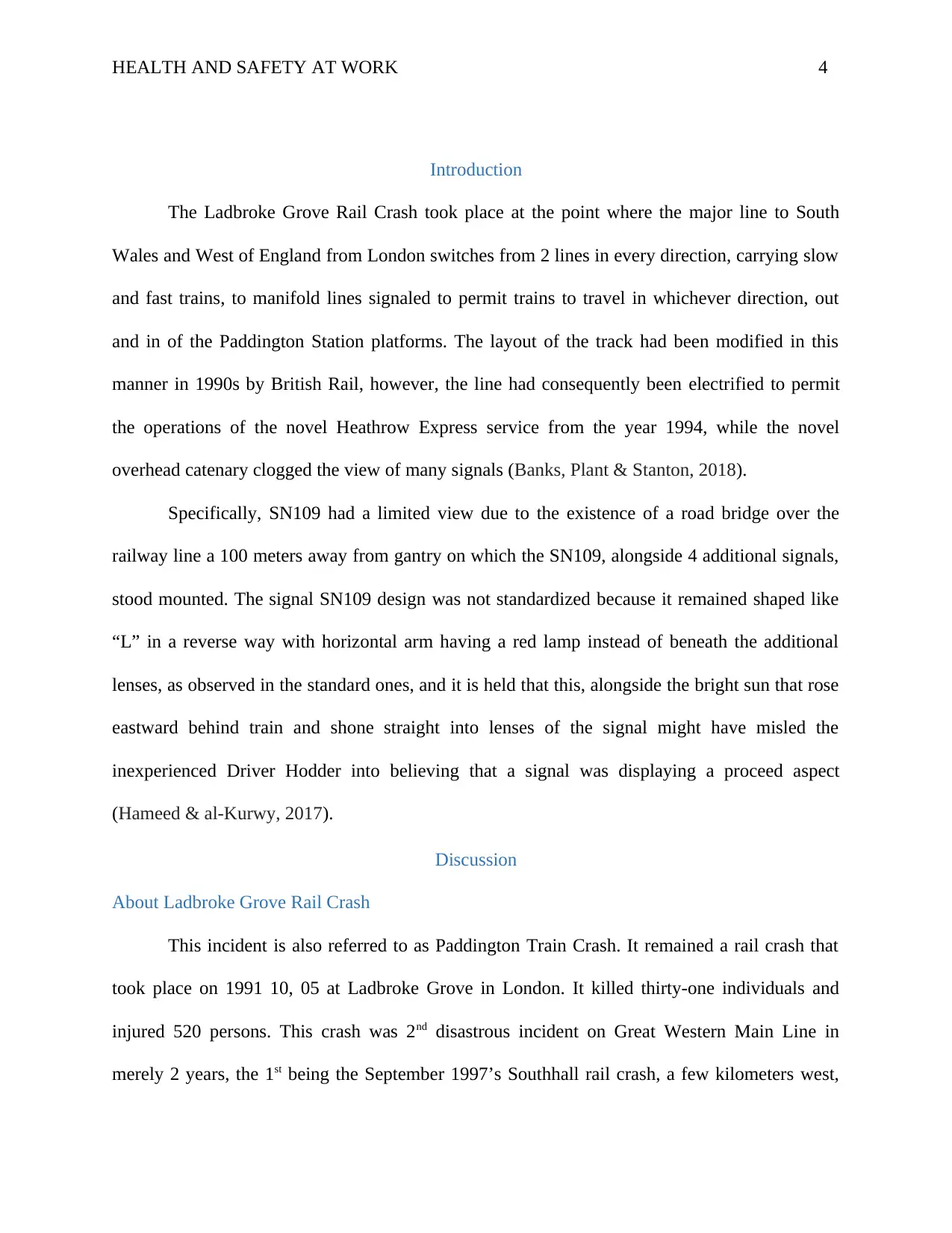
HEALTH AND SAFETY AT WORK 4
Introduction
The Ladbroke Grove Rail Crash took place at the point where the major line to South
Wales and West of England from London switches from 2 lines in every direction, carrying slow
and fast trains, to manifold lines signaled to permit trains to travel in whichever direction, out
and in of the Paddington Station platforms. The layout of the track had been modified in this
manner in 1990s by British Rail, however, the line had consequently been electrified to permit
the operations of the novel Heathrow Express service from the year 1994, while the novel
overhead catenary clogged the view of many signals (Banks, Plant & Stanton, 2018).
Specifically, SN109 had a limited view due to the existence of a road bridge over the
railway line a 100 meters away from gantry on which the SN109, alongside 4 additional signals,
stood mounted. The signal SN109 design was not standardized because it remained shaped like
“L” in a reverse way with horizontal arm having a red lamp instead of beneath the additional
lenses, as observed in the standard ones, and it is held that this, alongside the bright sun that rose
eastward behind train and shone straight into lenses of the signal might have misled the
inexperienced Driver Hodder into believing that a signal was displaying a proceed aspect
(Hameed & al-Kurwy, 2017).
Discussion
About Ladbroke Grove Rail Crash
This incident is also referred to as Paddington Train Crash. It remained a rail crash that
took place on 1991 10, 05 at Ladbroke Grove in London. It killed thirty-one individuals and
injured 520 persons. This crash was 2nd disastrous incident on Great Western Main Line in
merely 2 years, the 1st being the September 1997’s Southhall rail crash, a few kilometers west,
Introduction
The Ladbroke Grove Rail Crash took place at the point where the major line to South
Wales and West of England from London switches from 2 lines in every direction, carrying slow
and fast trains, to manifold lines signaled to permit trains to travel in whichever direction, out
and in of the Paddington Station platforms. The layout of the track had been modified in this
manner in 1990s by British Rail, however, the line had consequently been electrified to permit
the operations of the novel Heathrow Express service from the year 1994, while the novel
overhead catenary clogged the view of many signals (Banks, Plant & Stanton, 2018).
Specifically, SN109 had a limited view due to the existence of a road bridge over the
railway line a 100 meters away from gantry on which the SN109, alongside 4 additional signals,
stood mounted. The signal SN109 design was not standardized because it remained shaped like
“L” in a reverse way with horizontal arm having a red lamp instead of beneath the additional
lenses, as observed in the standard ones, and it is held that this, alongside the bright sun that rose
eastward behind train and shone straight into lenses of the signal might have misled the
inexperienced Driver Hodder into believing that a signal was displaying a proceed aspect
(Hameed & al-Kurwy, 2017).
Discussion
About Ladbroke Grove Rail Crash
This incident is also referred to as Paddington Train Crash. It remained a rail crash that
took place on 1991 10, 05 at Ladbroke Grove in London. It killed thirty-one individuals and
injured 520 persons. This crash was 2nd disastrous incident on Great Western Main Line in
merely 2 years, the 1st being the September 1997’s Southhall rail crash, a few kilometers west,
Paraphrase This Document
Need a fresh take? Get an instant paraphrase of this document with our AI Paraphraser

HEALTH AND SAFETY AT WORK 5
and it seriously ruined public confidence in Britain’s privatized railway system’s safety. It started
at 08:58 BST when Thames Trains’ 3-car Class 165-diesel multiple unit train (number 165 115)
crashed with a First Great Western High Speed Train comprises of 8 Mark-3 passenger-carriages
alongside a Class 43 power car at both ends (43011-43018) at Ladbroke Grove junction, nearly 2
miles west of terminus at Paddington station.
The collision was nearly head-on at this intersection with a merged closing speed
approximated to be 210 kilometer per hour. The Thames train’s first car, 0806 heading to
Bedwyn from Paddington under the control of Michael Hodder, remained completely
demolished on the impact, while diesel fuel that was carried inside the train at beginning of its
every day trip kindled, triggering a sequence of distinct fires in the train rubble, specifically in
coach H at HST’s front that was fully burned out. A total of 31 individuals onboard including the
drivers of the two trains succumbed, and 227 persons got admission at the hospital while a
further 296 people got treatment at the crash’s site for negligible injuries (Wreathall, 2016).
Contributing Safety Breaches
The investigation identified the Themes train passing signal SN 109 as the immediate
cause of the crash when it was displaying a red light which was recognized technically as a
Signal Passed at Danger or SPAD, 563 meters away from the eventual impact point. Lord
Cullen-led public inquiry the following year acknowledged several contributing factors, and
blamed the driver training procedures of Thames Train. This is because despite having an
established procedure for training its drivers, Thames Train never followed it in the case of
driver Hodder. Mr. Hodder only responded to the advertisement in the local newspaper; but
never filled in application form as required in Thames Train’s recruitment procedure. This means
that Thames Train breached safety by not asking driver Hodder to fill the form and hence he
and it seriously ruined public confidence in Britain’s privatized railway system’s safety. It started
at 08:58 BST when Thames Trains’ 3-car Class 165-diesel multiple unit train (number 165 115)
crashed with a First Great Western High Speed Train comprises of 8 Mark-3 passenger-carriages
alongside a Class 43 power car at both ends (43011-43018) at Ladbroke Grove junction, nearly 2
miles west of terminus at Paddington station.
The collision was nearly head-on at this intersection with a merged closing speed
approximated to be 210 kilometer per hour. The Thames train’s first car, 0806 heading to
Bedwyn from Paddington under the control of Michael Hodder, remained completely
demolished on the impact, while diesel fuel that was carried inside the train at beginning of its
every day trip kindled, triggering a sequence of distinct fires in the train rubble, specifically in
coach H at HST’s front that was fully burned out. A total of 31 individuals onboard including the
drivers of the two trains succumbed, and 227 persons got admission at the hospital while a
further 296 people got treatment at the crash’s site for negligible injuries (Wreathall, 2016).
Contributing Safety Breaches
The investigation identified the Themes train passing signal SN 109 as the immediate
cause of the crash when it was displaying a red light which was recognized technically as a
Signal Passed at Danger or SPAD, 563 meters away from the eventual impact point. Lord
Cullen-led public inquiry the following year acknowledged several contributing factors, and
blamed the driver training procedures of Thames Train. This is because despite having an
established procedure for training its drivers, Thames Train never followed it in the case of
driver Hodder. Mr. Hodder only responded to the advertisement in the local newspaper; but
never filled in application form as required in Thames Train’s recruitment procedure. This means
that Thames Train breached safety by not asking driver Hodder to fill the form and hence he
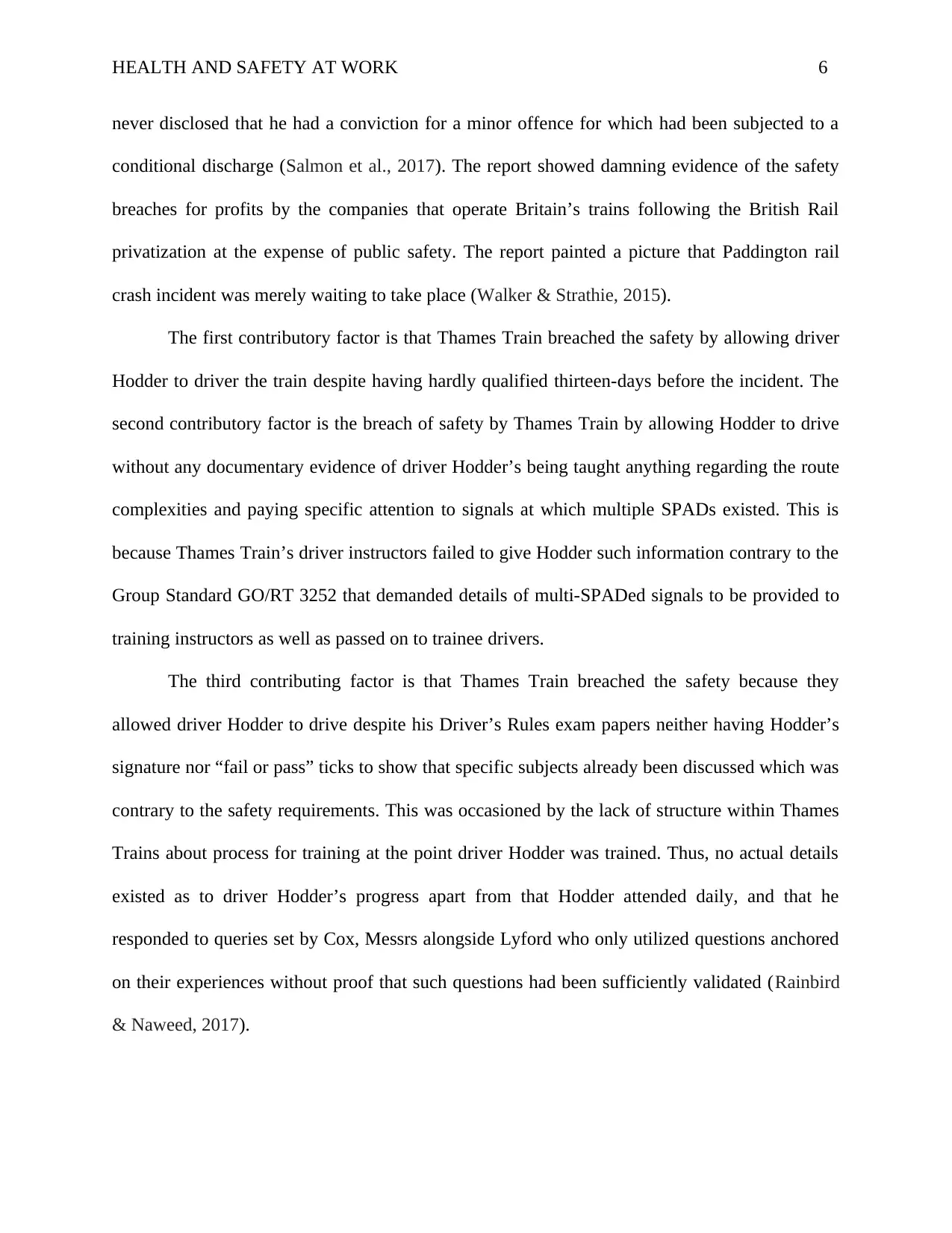
HEALTH AND SAFETY AT WORK 6
never disclosed that he had a conviction for a minor offence for which had been subjected to a
conditional discharge (Salmon et al., 2017). The report showed damning evidence of the safety
breaches for profits by the companies that operate Britain’s trains following the British Rail
privatization at the expense of public safety. The report painted a picture that Paddington rail
crash incident was merely waiting to take place (Walker & Strathie, 2015).
The first contributory factor is that Thames Train breached the safety by allowing driver
Hodder to driver the train despite having hardly qualified thirteen-days before the incident. The
second contributory factor is the breach of safety by Thames Train by allowing Hodder to drive
without any documentary evidence of driver Hodder’s being taught anything regarding the route
complexities and paying specific attention to signals at which multiple SPADs existed. This is
because Thames Train’s driver instructors failed to give Hodder such information contrary to the
Group Standard GO/RT 3252 that demanded details of multi-SPADed signals to be provided to
training instructors as well as passed on to trainee drivers.
The third contributing factor is that Thames Train breached the safety because they
allowed driver Hodder to drive despite his Driver’s Rules exam papers neither having Hodder’s
signature nor “fail or pass” ticks to show that specific subjects already been discussed which was
contrary to the safety requirements. This was occasioned by the lack of structure within Thames
Trains about process for training at the point driver Hodder was trained. Thus, no actual details
existed as to driver Hodder’s progress apart from that Hodder attended daily, and that he
responded to queries set by Cox, Messrs alongside Lyford who only utilized questions anchored
on their experiences without proof that such questions had been sufficiently validated (Rainbird
& Naweed, 2017).
never disclosed that he had a conviction for a minor offence for which had been subjected to a
conditional discharge (Salmon et al., 2017). The report showed damning evidence of the safety
breaches for profits by the companies that operate Britain’s trains following the British Rail
privatization at the expense of public safety. The report painted a picture that Paddington rail
crash incident was merely waiting to take place (Walker & Strathie, 2015).
The first contributory factor is that Thames Train breached the safety by allowing driver
Hodder to driver the train despite having hardly qualified thirteen-days before the incident. The
second contributory factor is the breach of safety by Thames Train by allowing Hodder to drive
without any documentary evidence of driver Hodder’s being taught anything regarding the route
complexities and paying specific attention to signals at which multiple SPADs existed. This is
because Thames Train’s driver instructors failed to give Hodder such information contrary to the
Group Standard GO/RT 3252 that demanded details of multi-SPADed signals to be provided to
training instructors as well as passed on to trainee drivers.
The third contributing factor is that Thames Train breached the safety because they
allowed driver Hodder to drive despite his Driver’s Rules exam papers neither having Hodder’s
signature nor “fail or pass” ticks to show that specific subjects already been discussed which was
contrary to the safety requirements. This was occasioned by the lack of structure within Thames
Trains about process for training at the point driver Hodder was trained. Thus, no actual details
existed as to driver Hodder’s progress apart from that Hodder attended daily, and that he
responded to queries set by Cox, Messrs alongside Lyford who only utilized questions anchored
on their experiences without proof that such questions had been sufficiently validated (Rainbird
& Naweed, 2017).
⊘ This is a preview!⊘
Do you want full access?
Subscribe today to unlock all pages.

Trusted by 1+ million students worldwide

HEALTH AND SAFETY AT WORK 7
The inquiry also attributed Railtrack’s Great Western Zone as a cause of the crash since it
was responsible for the track maintenance and signaling and breached the safety rules by failing
to take any appropriate actions in lieu of the fact that eight SPADs had existed at the signal SN
109 in the past six years leading to the crash (even though all such trains halted prior to arriving
at this junction), or adopted adequate actions in reaction to complaints from the drivers of the
train regarding the visibility of a range of signals, specifically SN 109.
The inquiry also identified and criticized the H&S Executive’s HMRI for the breaches
with regards to its procedures for inspections. The Railtrack signaling center employees at
Slough (Integrated Electronic Control Centre) stood further recognized as a causative factor as
they never sent a radio “emergency all stop” signal instantly where they recognized that the
Thames Train had already passed a signal at danger. They breached the safety requirements by
assuming that the train would halt shortly following the signal as had occurred with previous
SPADs at such signal, and it is never known if the radio signal ultimately sent stood received
prior to the impact thirty-three seconds later (Rashidy, Hughes, Figueres-Esteban, Harrison &
Van Gulijk, 2018).
Another breach was by the Railtrack due to insufficient and qualified signalers. This is
because once Hodder had already passed the red light at the SN109, the obligation to avert the
crash lay with signalers, who were the employees of Railtrack. Specifically, Mr. D Allen was the
staff on duty who would have controlled the signals and sent it to Hodder to avert the accident.
However, Allen had worked the entire week for over 72 hours and had been compelled in a cruel
irony to work extra hours since Railtrack had insufficient staffs. Thus, no adequate signalers
were available to cover operations since the colleagues had attended the Southhall crash inquiry
on same day the Ladbroke Grove Rail crash took place. Despite the existence of forty-six SPADs
The inquiry also attributed Railtrack’s Great Western Zone as a cause of the crash since it
was responsible for the track maintenance and signaling and breached the safety rules by failing
to take any appropriate actions in lieu of the fact that eight SPADs had existed at the signal SN
109 in the past six years leading to the crash (even though all such trains halted prior to arriving
at this junction), or adopted adequate actions in reaction to complaints from the drivers of the
train regarding the visibility of a range of signals, specifically SN 109.
The inquiry also identified and criticized the H&S Executive’s HMRI for the breaches
with regards to its procedures for inspections. The Railtrack signaling center employees at
Slough (Integrated Electronic Control Centre) stood further recognized as a causative factor as
they never sent a radio “emergency all stop” signal instantly where they recognized that the
Thames Train had already passed a signal at danger. They breached the safety requirements by
assuming that the train would halt shortly following the signal as had occurred with previous
SPADs at such signal, and it is never known if the radio signal ultimately sent stood received
prior to the impact thirty-three seconds later (Rashidy, Hughes, Figueres-Esteban, Harrison &
Van Gulijk, 2018).
Another breach was by the Railtrack due to insufficient and qualified signalers. This is
because once Hodder had already passed the red light at the SN109, the obligation to avert the
crash lay with signalers, who were the employees of Railtrack. Specifically, Mr. D Allen was the
staff on duty who would have controlled the signals and sent it to Hodder to avert the accident.
However, Allen had worked the entire week for over 72 hours and had been compelled in a cruel
irony to work extra hours since Railtrack had insufficient staffs. Thus, no adequate signalers
were available to cover operations since the colleagues had attended the Southhall crash inquiry
on same day the Ladbroke Grove Rail crash took place. Despite the existence of forty-six SPADs
Paraphrase This Document
Need a fresh take? Get an instant paraphrase of this document with our AI Paraphraser
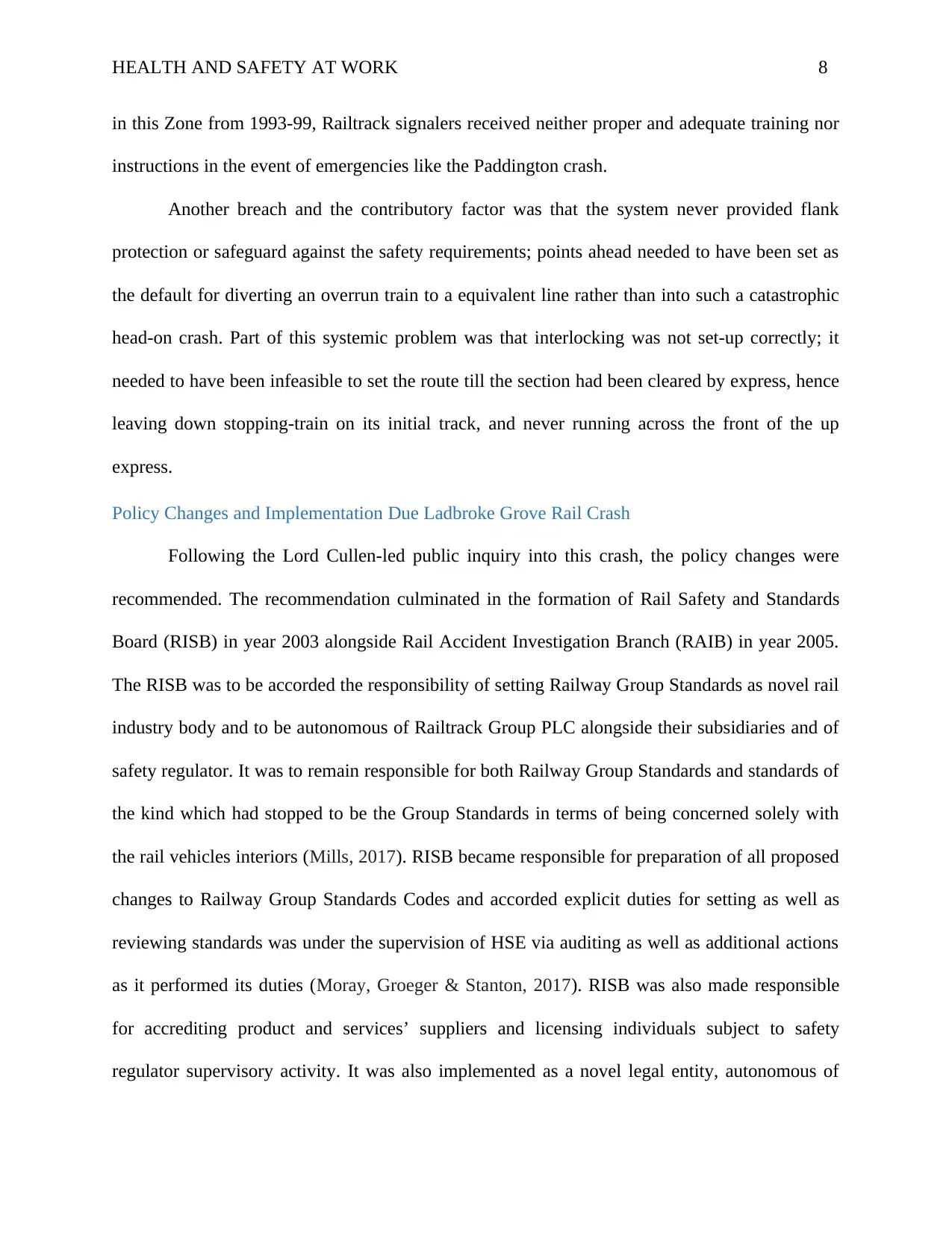
HEALTH AND SAFETY AT WORK 8
in this Zone from 1993-99, Railtrack signalers received neither proper and adequate training nor
instructions in the event of emergencies like the Paddington crash.
Another breach and the contributory factor was that the system never provided flank
protection or safeguard against the safety requirements; points ahead needed to have been set as
the default for diverting an overrun train to a equivalent line rather than into such a catastrophic
head-on crash. Part of this systemic problem was that interlocking was not set-up correctly; it
needed to have been infeasible to set the route till the section had been cleared by express, hence
leaving down stopping-train on its initial track, and never running across the front of the up
express.
Policy Changes and Implementation Due Ladbroke Grove Rail Crash
Following the Lord Cullen-led public inquiry into this crash, the policy changes were
recommended. The recommendation culminated in the formation of Rail Safety and Standards
Board (RISB) in year 2003 alongside Rail Accident Investigation Branch (RAIB) in year 2005.
The RISB was to be accorded the responsibility of setting Railway Group Standards as novel rail
industry body and to be autonomous of Railtrack Group PLC alongside their subsidiaries and of
safety regulator. It was to remain responsible for both Railway Group Standards and standards of
the kind which had stopped to be the Group Standards in terms of being concerned solely with
the rail vehicles interiors (Mills, 2017). RISB became responsible for preparation of all proposed
changes to Railway Group Standards Codes and accorded explicit duties for setting as well as
reviewing standards was under the supervision of HSE via auditing as well as additional actions
as it performed its duties (Moray, Groeger & Stanton, 2017). RISB was also made responsible
for accrediting product and services’ suppliers and licensing individuals subject to safety
regulator supervisory activity. It was also implemented as a novel legal entity, autonomous of
in this Zone from 1993-99, Railtrack signalers received neither proper and adequate training nor
instructions in the event of emergencies like the Paddington crash.
Another breach and the contributory factor was that the system never provided flank
protection or safeguard against the safety requirements; points ahead needed to have been set as
the default for diverting an overrun train to a equivalent line rather than into such a catastrophic
head-on crash. Part of this systemic problem was that interlocking was not set-up correctly; it
needed to have been infeasible to set the route till the section had been cleared by express, hence
leaving down stopping-train on its initial track, and never running across the front of the up
express.
Policy Changes and Implementation Due Ladbroke Grove Rail Crash
Following the Lord Cullen-led public inquiry into this crash, the policy changes were
recommended. The recommendation culminated in the formation of Rail Safety and Standards
Board (RISB) in year 2003 alongside Rail Accident Investigation Branch (RAIB) in year 2005.
The RISB was to be accorded the responsibility of setting Railway Group Standards as novel rail
industry body and to be autonomous of Railtrack Group PLC alongside their subsidiaries and of
safety regulator. It was to remain responsible for both Railway Group Standards and standards of
the kind which had stopped to be the Group Standards in terms of being concerned solely with
the rail vehicles interiors (Mills, 2017). RISB became responsible for preparation of all proposed
changes to Railway Group Standards Codes and accorded explicit duties for setting as well as
reviewing standards was under the supervision of HSE via auditing as well as additional actions
as it performed its duties (Moray, Groeger & Stanton, 2017). RISB was also made responsible
for accrediting product and services’ suppliers and licensing individuals subject to safety
regulator supervisory activity. It was also implemented as a novel legal entity, autonomous of
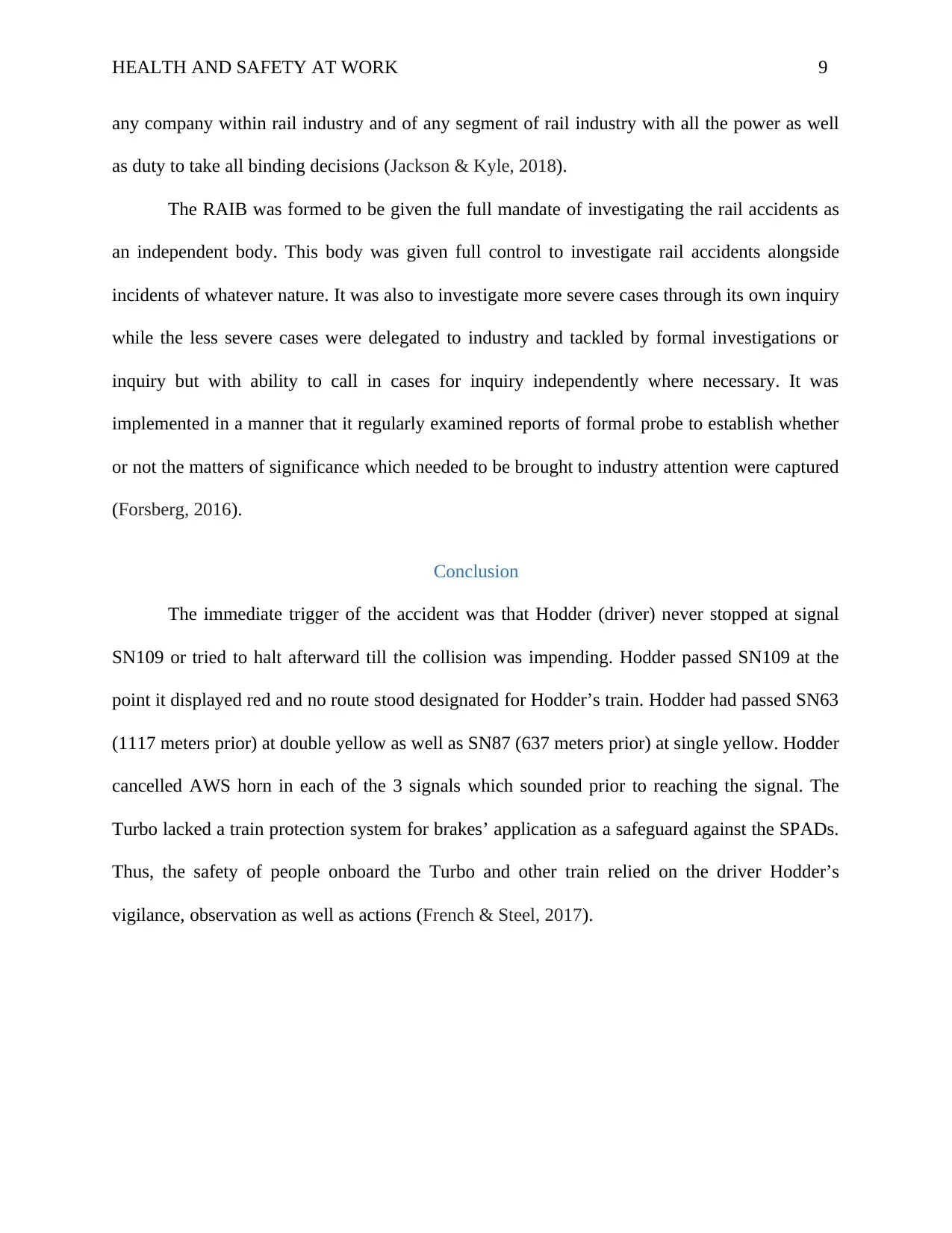
HEALTH AND SAFETY AT WORK 9
any company within rail industry and of any segment of rail industry with all the power as well
as duty to take all binding decisions (Jackson & Kyle, 2018).
The RAIB was formed to be given the full mandate of investigating the rail accidents as
an independent body. This body was given full control to investigate rail accidents alongside
incidents of whatever nature. It was also to investigate more severe cases through its own inquiry
while the less severe cases were delegated to industry and tackled by formal investigations or
inquiry but with ability to call in cases for inquiry independently where necessary. It was
implemented in a manner that it regularly examined reports of formal probe to establish whether
or not the matters of significance which needed to be brought to industry attention were captured
(Forsberg, 2016).
Conclusion
The immediate trigger of the accident was that Hodder (driver) never stopped at signal
SN109 or tried to halt afterward till the collision was impending. Hodder passed SN109 at the
point it displayed red and no route stood designated for Hodder’s train. Hodder had passed SN63
(1117 meters prior) at double yellow as well as SN87 (637 meters prior) at single yellow. Hodder
cancelled AWS horn in each of the 3 signals which sounded prior to reaching the signal. The
Turbo lacked a train protection system for brakes’ application as a safeguard against the SPADs.
Thus, the safety of people onboard the Turbo and other train relied on the driver Hodder’s
vigilance, observation as well as actions (French & Steel, 2017).
any company within rail industry and of any segment of rail industry with all the power as well
as duty to take all binding decisions (Jackson & Kyle, 2018).
The RAIB was formed to be given the full mandate of investigating the rail accidents as
an independent body. This body was given full control to investigate rail accidents alongside
incidents of whatever nature. It was also to investigate more severe cases through its own inquiry
while the less severe cases were delegated to industry and tackled by formal investigations or
inquiry but with ability to call in cases for inquiry independently where necessary. It was
implemented in a manner that it regularly examined reports of formal probe to establish whether
or not the matters of significance which needed to be brought to industry attention were captured
(Forsberg, 2016).
Conclusion
The immediate trigger of the accident was that Hodder (driver) never stopped at signal
SN109 or tried to halt afterward till the collision was impending. Hodder passed SN109 at the
point it displayed red and no route stood designated for Hodder’s train. Hodder had passed SN63
(1117 meters prior) at double yellow as well as SN87 (637 meters prior) at single yellow. Hodder
cancelled AWS horn in each of the 3 signals which sounded prior to reaching the signal. The
Turbo lacked a train protection system for brakes’ application as a safeguard against the SPADs.
Thus, the safety of people onboard the Turbo and other train relied on the driver Hodder’s
vigilance, observation as well as actions (French & Steel, 2017).
⊘ This is a preview!⊘
Do you want full access?
Subscribe today to unlock all pages.

Trusted by 1+ million students worldwide
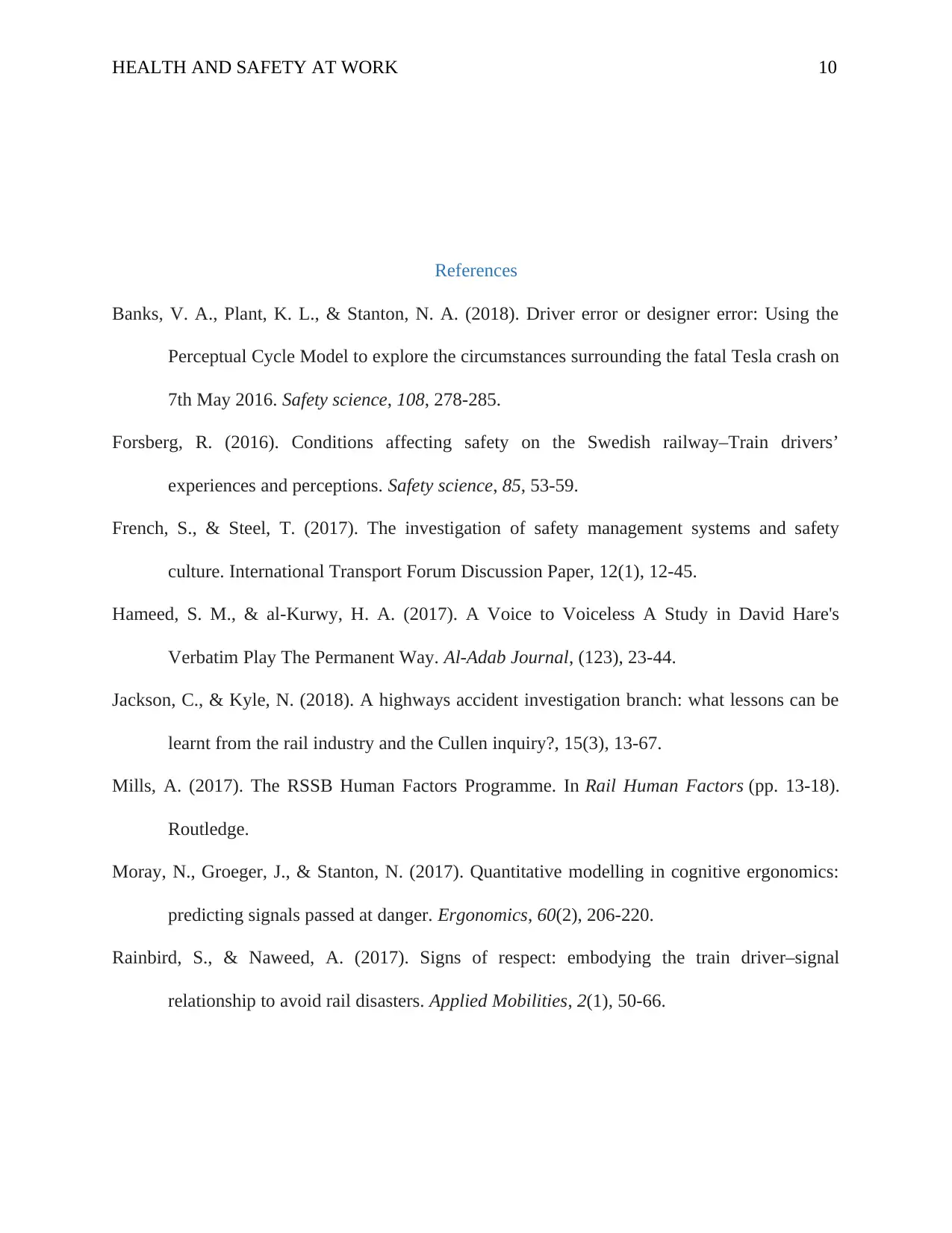
HEALTH AND SAFETY AT WORK 10
References
Banks, V. A., Plant, K. L., & Stanton, N. A. (2018). Driver error or designer error: Using the
Perceptual Cycle Model to explore the circumstances surrounding the fatal Tesla crash on
7th May 2016. Safety science, 108, 278-285.
Forsberg, R. (2016). Conditions affecting safety on the Swedish railway–Train drivers’
experiences and perceptions. Safety science, 85, 53-59.
French, S., & Steel, T. (2017). The investigation of safety management systems and safety
culture. International Transport Forum Discussion Paper, 12(1), 12-45.
Hameed, S. M., & al-Kurwy, H. A. (2017). A Voice to Voiceless A Study in David Hare's
Verbatim Play The Permanent Way. Al-Adab Journal, (123), 23-44.
Jackson, C., & Kyle, N. (2018). A highways accident investigation branch: what lessons can be
learnt from the rail industry and the Cullen inquiry?, 15(3), 13-67.
Mills, A. (2017). The RSSB Human Factors Programme. In Rail Human Factors (pp. 13-18).
Routledge.
Moray, N., Groeger, J., & Stanton, N. (2017). Quantitative modelling in cognitive ergonomics:
predicting signals passed at danger. Ergonomics, 60(2), 206-220.
Rainbird, S., & Naweed, A. (2017). Signs of respect: embodying the train driver–signal
relationship to avoid rail disasters. Applied Mobilities, 2(1), 50-66.
References
Banks, V. A., Plant, K. L., & Stanton, N. A. (2018). Driver error or designer error: Using the
Perceptual Cycle Model to explore the circumstances surrounding the fatal Tesla crash on
7th May 2016. Safety science, 108, 278-285.
Forsberg, R. (2016). Conditions affecting safety on the Swedish railway–Train drivers’
experiences and perceptions. Safety science, 85, 53-59.
French, S., & Steel, T. (2017). The investigation of safety management systems and safety
culture. International Transport Forum Discussion Paper, 12(1), 12-45.
Hameed, S. M., & al-Kurwy, H. A. (2017). A Voice to Voiceless A Study in David Hare's
Verbatim Play The Permanent Way. Al-Adab Journal, (123), 23-44.
Jackson, C., & Kyle, N. (2018). A highways accident investigation branch: what lessons can be
learnt from the rail industry and the Cullen inquiry?, 15(3), 13-67.
Mills, A. (2017). The RSSB Human Factors Programme. In Rail Human Factors (pp. 13-18).
Routledge.
Moray, N., Groeger, J., & Stanton, N. (2017). Quantitative modelling in cognitive ergonomics:
predicting signals passed at danger. Ergonomics, 60(2), 206-220.
Rainbird, S., & Naweed, A. (2017). Signs of respect: embodying the train driver–signal
relationship to avoid rail disasters. Applied Mobilities, 2(1), 50-66.
Paraphrase This Document
Need a fresh take? Get an instant paraphrase of this document with our AI Paraphraser
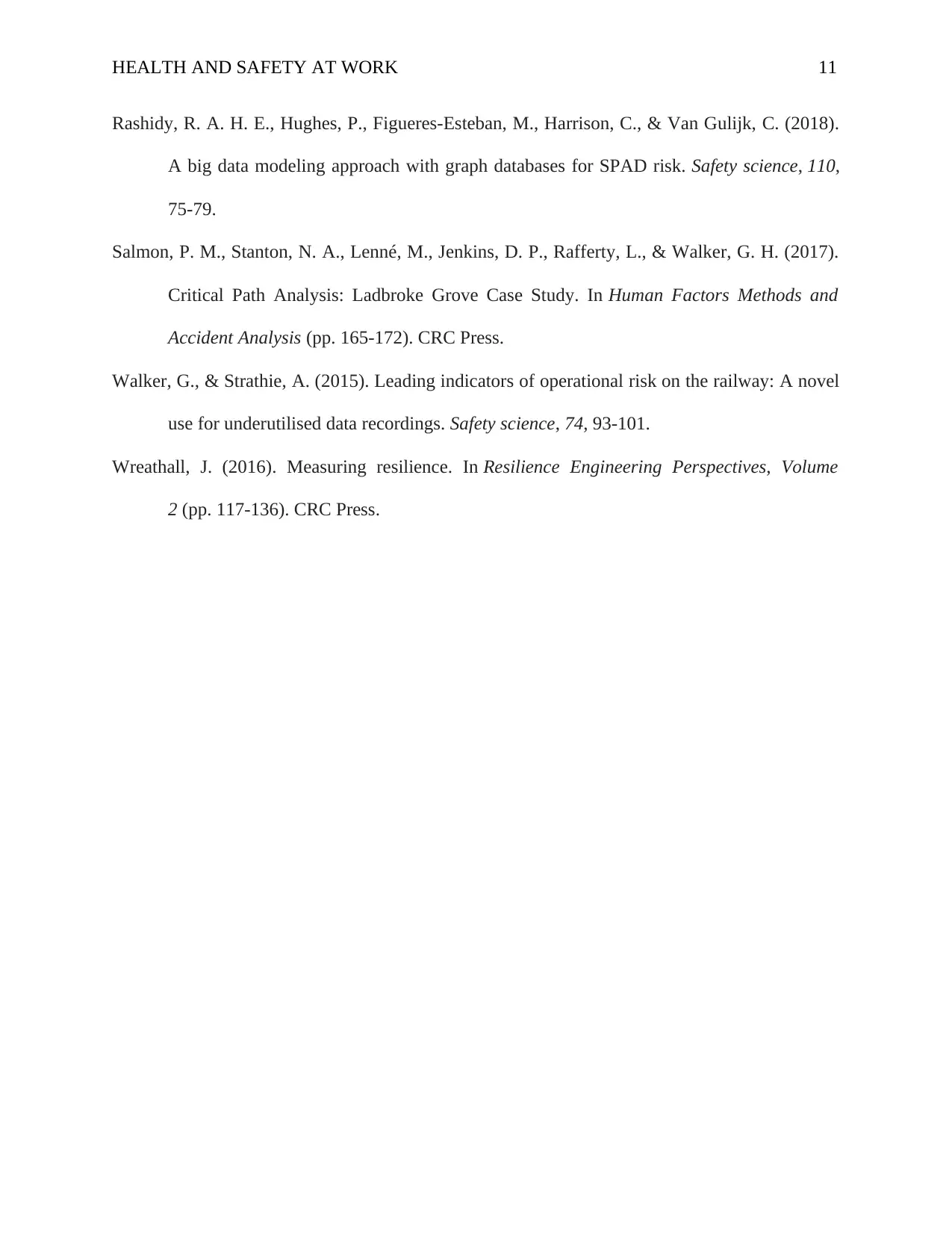
HEALTH AND SAFETY AT WORK 11
Rashidy, R. A. H. E., Hughes, P., Figueres-Esteban, M., Harrison, C., & Van Gulijk, C. (2018).
A big data modeling approach with graph databases for SPAD risk. Safety science, 110,
75-79.
Salmon, P. M., Stanton, N. A., Lenné, M., Jenkins, D. P., Rafferty, L., & Walker, G. H. (2017).
Critical Path Analysis: Ladbroke Grove Case Study. In Human Factors Methods and
Accident Analysis (pp. 165-172). CRC Press.
Walker, G., & Strathie, A. (2015). Leading indicators of operational risk on the railway: A novel
use for underutilised data recordings. Safety science, 74, 93-101.
Wreathall, J. (2016). Measuring resilience. In Resilience Engineering Perspectives, Volume
2 (pp. 117-136). CRC Press.
Rashidy, R. A. H. E., Hughes, P., Figueres-Esteban, M., Harrison, C., & Van Gulijk, C. (2018).
A big data modeling approach with graph databases for SPAD risk. Safety science, 110,
75-79.
Salmon, P. M., Stanton, N. A., Lenné, M., Jenkins, D. P., Rafferty, L., & Walker, G. H. (2017).
Critical Path Analysis: Ladbroke Grove Case Study. In Human Factors Methods and
Accident Analysis (pp. 165-172). CRC Press.
Walker, G., & Strathie, A. (2015). Leading indicators of operational risk on the railway: A novel
use for underutilised data recordings. Safety science, 74, 93-101.
Wreathall, J. (2016). Measuring resilience. In Resilience Engineering Perspectives, Volume
2 (pp. 117-136). CRC Press.
1 out of 11
Your All-in-One AI-Powered Toolkit for Academic Success.
+13062052269
info@desklib.com
Available 24*7 on WhatsApp / Email
![[object Object]](/_next/static/media/star-bottom.7253800d.svg)
Unlock your academic potential
Copyright © 2020–2025 A2Z Services. All Rights Reserved. Developed and managed by ZUCOL.


